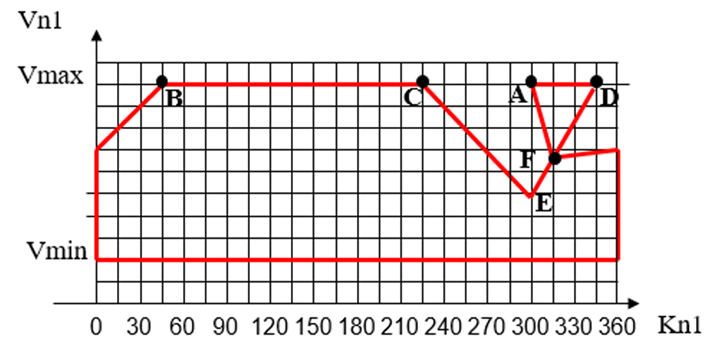Уникнення зіткнення шляхом побудови та використання області розходження у бортовому обчислювачі
DOI:
https://doi.org/10.15587/2706-5448.2023.274296Ключові слова:
розходження суден, безпека судноплавства, оптимізація процесів керування, автоматичний модуль керування, стенд імітаційного моделюванняАнотація
Об’єктом дослідження є процеси автоматичного оптимального розходження власного судна з багатьма небезпечними цілями, включаючи маневруючі, методом побудови у бортовому обчислювачі області допустимих параметрів розходження. За даними European Maritime Safety Agency (EMSA), найбільша кількість аварій суден у 2014–2019 роках відбулася по причині зіткнення (32 %). На сучасних суднах, для спостереження і розходження з цілями, використовується ЗАРП (засоби автоматичної радіолокаційної прокладки), який дозволяє автоматизувати ручні операції, а вбудована функція «Програвання маневру» надає навігатору зручний графічний інтерфейс для вирішення задач розходження. Разом з тим, ЗАРП – це автоматизована система, яка передбачає присутність оператора в контурі керування. Присутність людини у контурі керування пов’язана із «людським чинником», який є передумовою виникнення різних видів аварій, у тому числі і зіткнення суден. Найбільш ефективним засобом зменшення впливу «людського чинника» на процеси керування є запровадження автоматичних модулів керування у автоматизованих системах. У роботі розроблено метод для модуля розходження, який дозволяє автоматично та оптимально розходитися з багатьма цілями, включаючи маневруючі. Кількість цілей для розходження не обмежується методом, а обмежується лише можливостями ЗАРП по супроводженню цілей. Отримані результати пояснюються тим, що на кожному кроці бортового обчислювача будується область допустимих параметрів розходження з усіма цілями, із побудованої області вибираються параметри розходження, що оптимізують заданий критерій оптимальності, вибрані параметри використовуються як програмні у законі керування. Розроблений метод може використовуватися на суднах, за умови інтегрування в існуючу автоматизовану систему бортового обчислювача з відкритою архітектурою, для нарощування можливостей автоматичного керування рухом, у даному випадку можливості автоматичного оптимального розходження з багатьма цілями, включаючи маневруючі.
Посилання
- Bole, A., Wall, A., Norris, A. (2013). Radar and ARPA manual: Radar, AIS and Target Tracking for Marine Radar Users. Elsevir, 552. Available at: https://www.amazon.com/Radar-ARPA-Manual-Target-Tracking-ebook/dp/B00GY5XEYO#reader_B00GY5XEYO2
- Navi-Trainer Professional 5000 (version 5.35) (2014). Instructor's Guide, 507.
- Nosov, P. S., Popovych, I. S., Cherniavskyi, V. V., Zinchenko, S. M., Prokopchuk, Y. A., Makarchuk, D. V. (2020). Automated identification of an operator anticipation on marine transport. Radio Electronics, Computer Science, Control, 3, 158–172. doi: https://doi.org/10.15588/1607-3274-2020-3-15
- Zinchenko, S. M., Mateichuk, V. M., Nosov, P. S., Popovych, I. S., Appazov, E. S. (2020). Improving the accuracy of automatic control with mathematical meter model in on-board controller. Radio Electronics, Computer Science, Control, 4, 197–207. doi: https://doi.org/10.15588/1607-3274-2020-4-19
- Shen, H., Hashimoto, H., Matsuda, A., Taniguchi, Y., Terada, D., Guo, C. (2019). Automatic collision avoidance of multiple ships based on deep Q-learning. Applied Ocean Research, 86, 268–288. doi: https://doi.org/10.1016/j.apor.2019.02.020
- Li, Y., Guo, Z., Yang, J., Fang, H., Hu, Y. (2018). Prediction of ship collision risk based on CART. IET Intelligent Transport Systems, 12 (10), 1345–1350. doi: https://doi.org/10.1049/iet-its.2018.5281
- Park, J., Choi, J., Choi, H. (2019). COLREGS‐compliant path planning considering time‐varying trajectory uncertainty of autonomous surface vehicle. Electronics Letters, 55 (4), 222–224. doi: https://doi.org/10.1049/el.2018.6680
- Huang, Y., Chen, L., van Gelder, P. H. A. J. M. (2019). Generalized velocity obstacle algorithm for preventing ship collisions at sea. Ocean Engineering, 173, 142–156. doi: https://doi.org/10.1016/j.oceaneng.2018.12.053
- Johansen, T. A., Cristoforo, A., Perez, T. (2016). Ship Collision Avoidance Using Scenario-Based Model Predictive Control. IFAC. Available at: https://pdfs.semanticscholar.org/34a3/c1a0b699774fadab417ca2f5ef422edb1f0b.pdf
- Zinchenko, S., Mateichuk, V., Nosov, P., Popovych, I., Solovey, O., Mamenko, P., Grosheva, O. (2020). Use of Simulator Equipment for the Development and Testing of Vessel Control Systems. Electrical, Control and Communication Engineering, 16 (2), 58–64. doi: https://doi.org/10.2478/ecce-2020-0009

##submission.downloads##
Опубліковано
Як цитувати
Номер
Розділ
Ліцензія
Авторське право (c) 2023 Serhii Zinchenko, Oleh Tovstokoryi, Oleksandr Sapronov, Kostiantin Tymofeiev, Andrii Petrovskyi, Artem Ivanov

Ця робота ліцензується відповідно до Creative Commons Attribution 4.0 International License.
Закріплення та умови передачі авторських прав (ідентифікація авторства) здійснюється у Ліцензійному договорі. Зокрема, автори залишають за собою право на авторство свого рукопису та передають журналу право першої публікації цієї роботи на умовах ліцензії Creative Commons CC BY. При цьому вони мають право укладати самостійно додаткові угоди, що стосуються неексклюзивного поширення роботи у тому вигляді, в якому вона була опублікована цим журналом, але за умови збереження посилання на першу публікацію статті в цьому журналі.








